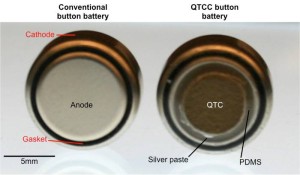
At left, a typical button battery; at right, a button battery coated with quantum tunneling composite (QTC).
Credit: Bryan Laulicht/MIT
We’ve heard a lot about innovation and improvements in the field of battery recently, but safety seems to have been put on the back-burner in lieu of creating a more powerful battery. This issue has now been addressed through funding from the National Institutes of Health in order to make technological breakthroughs in safety innovations for batteries.
According to the National Capital Poison Center, more than 3,500 people of all ages swallow button batteries every year in the United States. In order to combat the permanent injury that this could cause, researchers from MIT, Brigham and Women’s Hospital, and Massachusetts General Hospital have come together to create a coating that prevents batteries from conducing electricity after being swallowed – thereby causing no damage to the gastrointestinal tract.
Prior to this innovation, once a battery was swallowed, it would start to interact with the saliva and create an electric current. This current produces hydroxide, which causes damages to tissue. If not treated, this can cause serious injury within a few hours.
The new coating was designed to address this danger.
This from MIT:
Quantum tunneling composite (QTC), an off-the-shelf material commonly used in computer keyboards and touch screens, fit the bill perfectly. QTC is a rubberlike material, usually made of silicone, embedded with metal particles. Under normal circumstances, these particles are too far apart to conduct an electric current. However, when squeezed, the particles come closer together and start conducting. This allows QTC to switch from an insulator to a conductor, depending on how much pressure it is under.
Because the coating is relatively inexpensive and already used in other consumer products, the researchers believe battery companies should be able to implement it fairly easily.
While the coating is currently only being applied to button batteries, there are plans in motion to start testing the coating on other batteries – such as the lithium battery.
Here at ECS, we’re always looking for new and cutting-edge discoveries in battery. One of many symposium topics of the ECS 227th Meeting will be Batteries and Energy Storage. Get yourself and your research involved in the conversation by checking out the Call for Papers and submitting your abstracts here!


